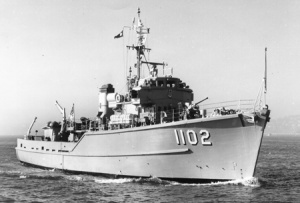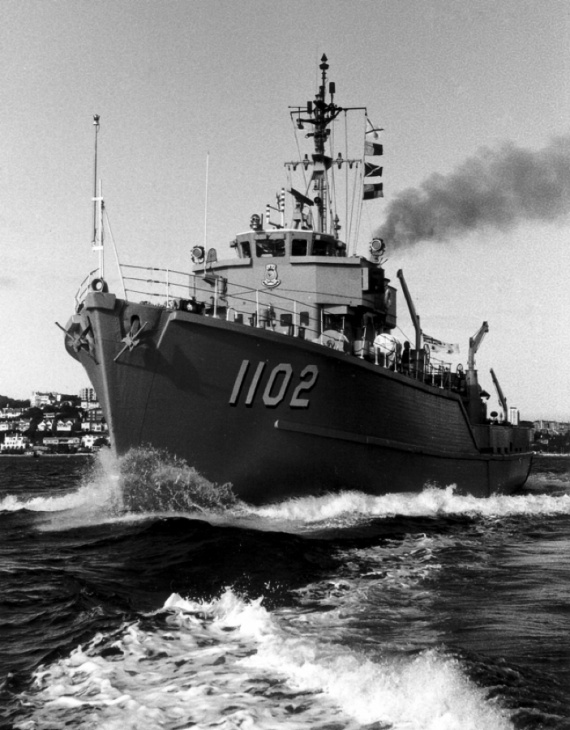HMAS Snipe
| Class |
Ton Class |
|---|---|
| Type |
Minesweeper |
| Pennant |
M1102 |
| Builder |
John I Thornycroft & Company, Southampton (Yard no. 4136) |
| Laid Down |
2 July 1951 |
| Launched |
4 September 1952 |
| Commissioned |
11 September 1962 |
| Decommissioned |
17 June 1983 |
| Dimensions & Displacement | |
| Displacement |
|
| Length | 46.6 metres (152 ft) |
| Beam | 8.8 metres (29 ft) |
| Draught | 2.5 metres (8 ft) |
| Performance | |
| Speed | 15 knots |
| Range |
|
| Complement | |
| Crew |
|
| Propulsion | |
| Machinery | 2 Napier Deltic Diesels |
| Horsepower | 3000 |
| Armament | |
| Guns | 1 single 40/60 Bofors |
| Awards | |
| Battle Honours | MALAYSIA 1964-66 |

HMAS Snipe was one of six ex-Royal Navy Ton Class minesweepers acquired by the Royal Australian Navy (RAN). Her sister ships were HMA Ships Hawk, Gull, Curlew, Ibis and Teal. The six Ton Class minesweepers formed the 16th Mine Countermeasures (MCM) Squadron and provided the RAN with the means to gain and maintain proficiency in mine countermeasures.
Snipe was originally commissioned into Royal Naval service as HMS Alcaston on 5 January 1954 to be the Leader of the 104th Minesweeper Squadron, based at Harwich, UK. Alcaston was decommissioned in 1957 and sent to Devonport for refit and preservation for the Reserve Fleet. She was purchased by the RAN in 1961 and commissioned as HMAS Snipe on 11 September 1962, under the command of Lieutenant M Rayment, RAN. She was the last of the six ex-Royal Navy Ton Class minesweepers to be commissioned into RAN service. She arrived in Sydney with her sister ships on 7 December 1962.
Snipe commenced a refit at Garden Island Dockyard on 1 February 1963. She emerged that April and, following sea trials, joined her sister ships conducing mine countermeasures exercises off the Australian east coast.
Snipe and her sister ships sailed for their first overseas deployment on 20 September 1963 as part of Operation GARDENING, a minesweeping task to clear a channel into Tonolei Harbour in Bougainville, where US aircraft had dropped a large number of magnetic mines in 1943. This was the RAN's biggest minesweeping operation for 16 years. The deployment also included overseas port visits to Singapore and Port Moresby, and the conduct of hydrographic surveys in the Solomon Sea and Chestnut Bay (125 miles south east of Port Moresby). The Squadron returned to Sydney that December and Snipe commenced a mid-cycle docking at Garden Island Dockyard.
Snipe recommenced mine countermeasures exercises on 29 January 1964, however, these exercises were suspended briefly from 11-13 February when she was called upon to assist in the search for survivors of the Melbourne/Voyager disaster. Following the search, Snipe returned to a routine exercise and maintenance programme until mid-April when she docked for repairs to her underwater nylon sheathing.
Snipe sailed for her first Far East Strategic Reserve (FESR) deployment in company with Curlew at the end of May to support anti-infiltration patrols in Malaysian waters. Relieved by Hawk and Gull, Snipe and Curlew returned to Sydney in February 1965 and Snipe entered Garden Island Dockyard for a refit.
Snipe commenced her second FESR deployment in September 1965, once again in company with Curlew, remaining deployed until the end of the Indonesian Confrontation in August 1966. By the time she returned home on 9 December 1966, Snipe had steamed approximately 52,000 nautical miles on active service in her second FESR deployment.
Upon returning to Australia, and due to maintenance costs and personnel shortages, Snipe was paid off into the Operational Reserve on 16 December 1966. On 2 March 1968, however, she was recommissioned back into active service.
Following a range of trials and exercises, Snipe departed for South East Asia in company with Gull and Hawk from late April until early July 1968 during which she participated in Exercises SMALL FRY and SHORT PLAY with units from the Royal Navy, and the United States and Philippines Navies.
Snipe deployed overseas once again to Papua New Guinea in September in company with Gull and Hawk where the three MCMs swept an approach channel to Marshall Lagoon. She operated in Australian waters for the remainder of the year, participating in Exercise SHADOW in October, and preparing, once again, for decommissioning.
On 13 December 1968, Snipe was once again paid off into operational reserve. Over the next two years from April 1969 to December 1970, Snipe remained in dockyard hands undergoing conversion to become a minehunter. The main elements of this conversion included fitting a Plessey A/S 193 high definition short range sonar into her existing dome space as part of the Mine-hunting System (Acoustic) Mark 1 (MHSA 1); modernising the bridge and operations room; removing the influence minesweeping systems; fitting a one-man recompression chamber; and replacing the existing rudders with active rudders. As a result of her conversion, Snipe’s complement was decreased from 38 to 31; 3 officers and 28 sailors, including a Clearance Diving Team.
On 8 February 1971, with her conversion completed, Snipe was recommissioned under the command of Lieutenant D Ramsden, RAN.
Snipe deployed to Papua New Guinea in company with Hawk and Curlew in late May 1971 to commence a Mine Warfare Pilotage Survey and South West Pacific deployment during which they provided aid to the civil power in New Britain, Rabaul, in the aftermath of an earthquake. She entered a ten-week refit and leave period in late November, seeing the year out in dock.
Snipe maintained a normal exercise and maintenance program in Australian waters for the first half of 1972 prior to departing for a four and a half month Far East deployment on 26 June 1972, in company with Curlew and Teal, during which they conducted general survey duties, cleared a WWII minefield in the vicinity of Port Moresby and participated in the SEATO Exercise SEA SCORPION. During this deployment Curlew and Snipe were called upon to search the waters off Penang to locate the remains of a Royal Malaysian Air Force Sabre jet fighter which had crashed in the sea after the pilot had been forced to eject. After an eleven hour search, Curlew located the wreckage of the aircraft in 32 feet of water.
Upon her return, Snipe remained in Australian waters until 1975, conducting a routine exercise and maintenance programme, including participation in Exercise KANGAROO ONE in June 1974.
Snipe once again deployed to Papua New Guinea in March 1975 in company with Ibis and Curlew, to contribute to Operation STILL DUSTY to clear mines laid by Australian forces during WWII in Bootless Inlet, near Port Moresby and which now impeded the laying of a submarine telecommunications cable between Port Moresby and Cairns. Post-war minesweeping had rendered the area safe for surface navigation, but not for cable-laying or other underwater activities. This was the largest mine-hunting operation by the RAN to date which involved the detection and clearing of mines from an area of 12 square kilometres by the end of April.
Snipe returned to Australian waters in May 1975 and commenced survey operations, most notably in the approaches to Darwin in the aftermath of Cyclone Tracy. During the month long operation, several sunken trawlers and other navigational hazards were located, most of them victims of the Cyclone, and whose fate had previously been unknown. On 22 September, Snipe was detached from surveying duties in South Australian waters to search for the wreckage of a crashed Bristol Freighter aircraft in Bass Strait. On 21 November, she was called upon once again to search for the wreckage of a crashed aircraft; on this occasion, a Sea King helicopter which had ditched into the water near Shoalhaven Bight. Sonar contact was made on 28 October in 210 feet of water and a four-day resurfacing operation began on 8 November. Snipe towed the wreckage of the aircraft to Jervis Bay.
On 19 January 1976, Snipe, in company with Ibis, departed for New Zealand and became the first Australian warships to enter Westport Harbour, which had a bar of 2.8 metres, the same as the draught of the MCM vessels. For the remainder of the year, Snipe operated in Australian waters participating in the joint-service Exercise JUC 96 in March, and Exercise KANGAROO TWO in October.
Snipe entered a refit in December 1976 and emerged on 29 July 1977 to commence post-refit trials and workup. She conducted a short good-will visit to New Caledonia, in company with Ibis, in October, following which she resumed a normal exercise program on the east coast of Australia. Snipe apprehended an illegal Japanese fishing vessel, Eikuku Maru No 71 in February 1978 and entered a refit in September.
Snipe deployed in company with Curlew in July 1979 to conduct survey work in Northern Australian waters. In nine days of surveying, Snipe and Curlew completed 3,053 miles of soundings compared to 2,853 miles by three MCM vessels in 1978. A subsequent deployment to Indonesia was cancelled so Snipe and Curlew undertook a brief visit to Port Moresby in August instead. That October, Snipe participated in Exercise KANGAROO THREE and acted as the Official Starting Vessel for the Sydney to Hobart Yacht Race on Boxing Day. Snipe once again underwent a refit from February to June 1980 before recommencing exercises in eastern and northern Australian waters.
In February 1980, Snipe, Ibis and Curlew visited Tasmania to participate in festivities for the Hobart Regatta as well as undertaking mine countermeasures exercises including a team sweep along the northern Tasmanian coast. This sweep of 90 miles in 40 hours was the longest sweep attempted since WWII and was a record for RAN Ton Class MCMs. The trio followed this with a South West Pacific deployment from March to June which included visits to Port Moresby, Lombrum, Rabaul, Port Vila, Suva and Noumea, as well as exercises with the Papua New Guinean, Fijian and French navies. Snipe and Curlew returned to the South West Pacific in June 1981, however, this programmed two month deployment ended abruptly on 3 July when Snipe ran aground on a coral reef while entering Nuku’Alofa harbour. Snipe was refloated within hours but spent eight days in Tonga undergoing repairs.
Snipe participated in Exercise KANGAROO 81 in October/November 1981 prior to commencing a refit in late November. Emerging from her refit in April 1982, she resumed exercises in Australian waters and visited Port Moresby that November before returning to Sydney in early December.
Snipe participated in the Fleet Concentration Period in February of 1983, following which, on 17 and 18 February, she underwent a hull survey and inspection with a view to assessing the feasibility of an extension of life. Unfortunately the survey indicated that her hull deterioration had increased at an accelerated rate. Consequently her Certificate of Seaworthiness was withdrawn and she was unable to participate in the international Exercise CAKRAWALA BARU IV. She was permitted to continue limited operations within the confines of Sydney Harbour, conducting long overdue Mine Warfare Pilot Surveys, until her decommissioning on 17 June 1983, failing by just 3 months to post 21 years of service. Snipe remained in the Reserve Fleet until she was sold in 1985 to be broken up, having logged over 315,000 nautical miles in RAN service.








